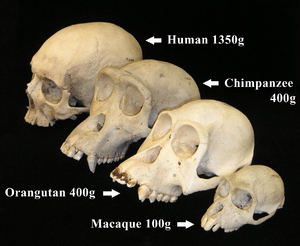Physical anthropology facts for kids
Physical anthropology is a super interesting part of anthropology that looks at how humans have changed over a very long time. It compares our bodies to those of other primates, like monkeys and apes. This field helps us understand where humans came from and how we became the way we are today.
When physical anthropology teams up with other science areas, it's often called biological anthropology. This wider field brings together clues from many places. It uses information from old fossils, studies the human skeleton, looks at our genetics (our DNA), and learns from our primate relatives. It also explores how humans have adapted to different environments and how our behavior has changed over time.
Contents
What is Physical Anthropology?
Physical anthropology is a science that studies humans from a biological point of view. It explores how our bodies have changed through evolution. Imagine looking at a family tree, but one that goes back millions of years! Physical anthropologists are like detectives trying to solve the mystery of human history.
They ask big questions like:
- How did humans evolve from earlier species?
- What makes us different from other animals?
- How do our bodies adapt to different places and ways of life?
Studying Human Evolution
A big part of physical anthropology is understanding human evolution. This means looking at how humans have changed and developed over millions of years. Scientists study many clues to piece together this amazing story.
Fossils and Ancient Bones
One of the most important clues comes from fossils. These are the preserved remains of ancient living things, like bones or teeth, that have turned into rock over time. Scientists who study these old human and pre-human fossils are called paleoanthropologists. They carefully dig up these fossils and study them to learn about our ancestors. For example, they can figure out how tall ancient humans were, what they ate, and even how they walked.
Our Primate Relatives
Another key area is primatology. This is the study of non-human primates, such as monkeys, apes, and lemurs. By observing how these animals live, move, and behave, physical anthropologists can learn more about the shared traits we have with them. This helps us understand what traits we might have inherited from our common ancestors. It also shows us how humans became unique.
Genetics and DNA
Modern physical anthropology also uses genetics. This is the study of DNA, which is like a blueprint for every living thing. By looking at the DNA of different human groups and comparing it to the DNA of other primates, scientists can trace our family tree and see how different populations are related. They can even find clues about ancient migrations and diseases.
How Humans Adapt
Physical anthropologists also study how humans adapt to their environments. For example, people living in very cold places might have different body shapes or ways their bodies handle the cold compared to people living in hot, sunny areas. This field looks at how our bodies change over generations to help us survive and thrive in different parts of the world. They also study how our diets and lifestyles affect our health and bodies.
Images for kids
-
Johann Friedrich Blumenbach was an early physical anthropologist.
-
Franz Boas is considered one of the founders of modern anthropology.
See also
 In Spanish: Antropología biológica para niños
In Spanish: Antropología biológica para niños




